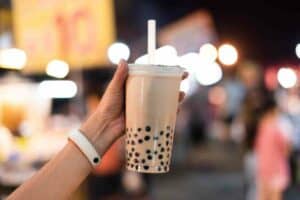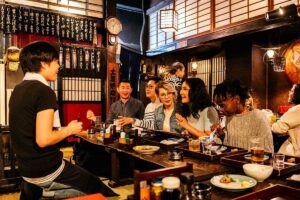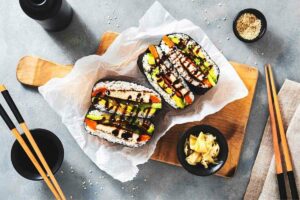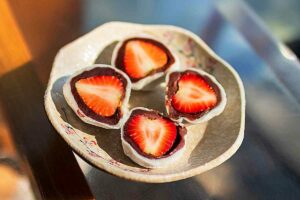Japanese street food isn’t as famous as its equivalents in Thailand, Vietnam, and other Southeast Asian countries.
Maybe, it’s the standards or the people’s culture, but its popularity doesn’t compare.
When you spot food stalls along streets, an event is likely ongoing in the country.
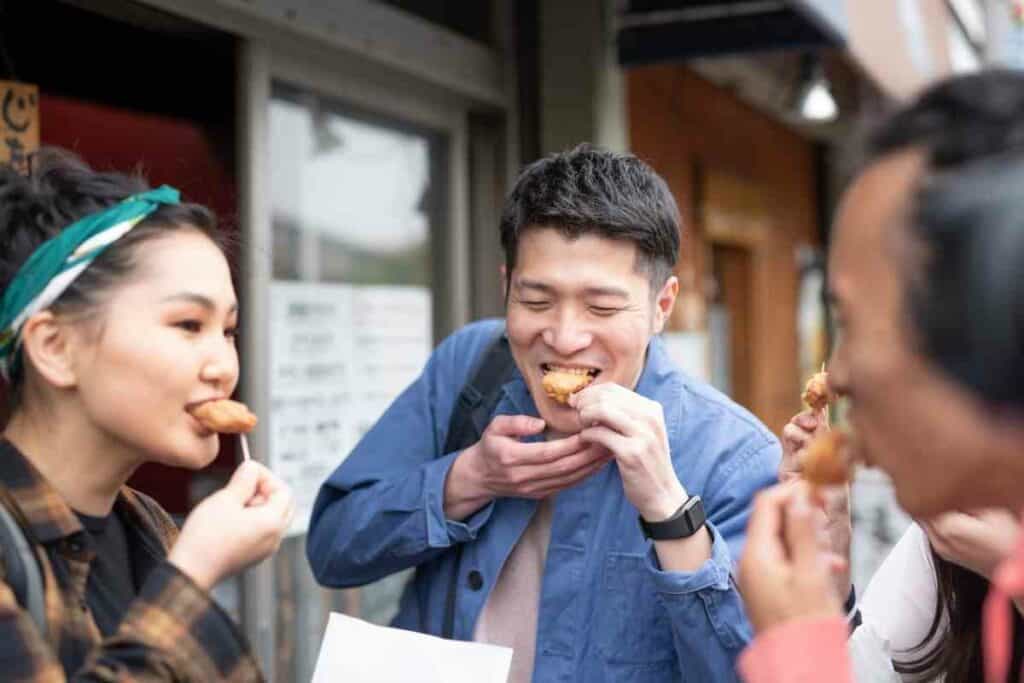
For example, Japan hosts hundreds of festivals yearly, and food vendors capitalize by setting up roadside stalls to give tourists a taste of Japanese street foods.
That said, some regions like the Nakasu District of Fukuoka have street food throughout the year.
If you get the chance to visit the Land of the Rising Sun, here are mouth-watering and affordable street dishes you need to try out.
Table of Contents
1. Takoyaki
Takoyaki is native to Osaka, a city famous for its diverse cuisines.
Takoyaki are small fried dough balls made from a batter containing eggs, flour, and dashi, a core soup in Japanese recipes.
Small pieces of octopus are added to the balls before drying to give a pleasant, chewy texture to the balls.
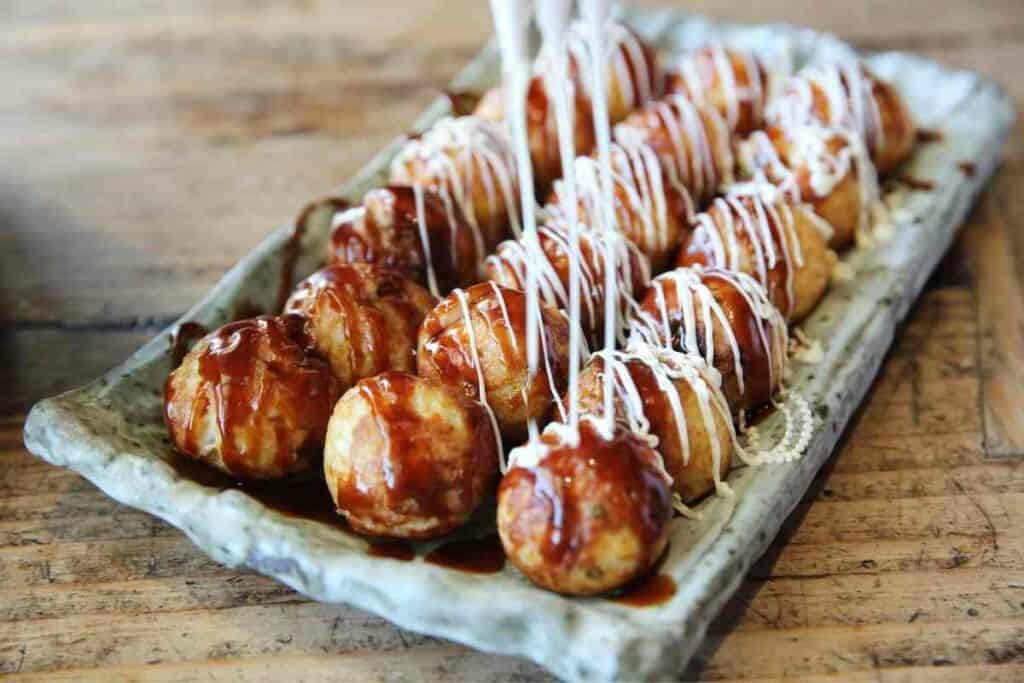
After frying, the chef tops them off with kewpie mayonnaise and a special takoyaki sauce. The final steps involved adding bonito flakes and green seaweed.
Nowadays, takoyaki is available in many variations. New variants include cheese, green onion, kimchi, and mayonnaise takoyaki.
Hot takoyaki is the best snack for a beer, as it’s crispy and soft inside.
Takoyaki is so famous that the country has many restaurants specializing in making it.
During festivals, you can find it all over the streets. It’s affordable, with ¥500 earning you eight pieces.
2. Karaage
Karaage, also called Japanese fried chicken, is a timeless classic savored by all, regardless of age.
It’s readily available in ikizaya (traditional Japanese pubs), supermarkets, and many convenience stores across Japan.
The dish consists of boneless, skin-on chicken thighs marinated in a mixture of mirin, sake, soy sauce, and in some instances, ginger.
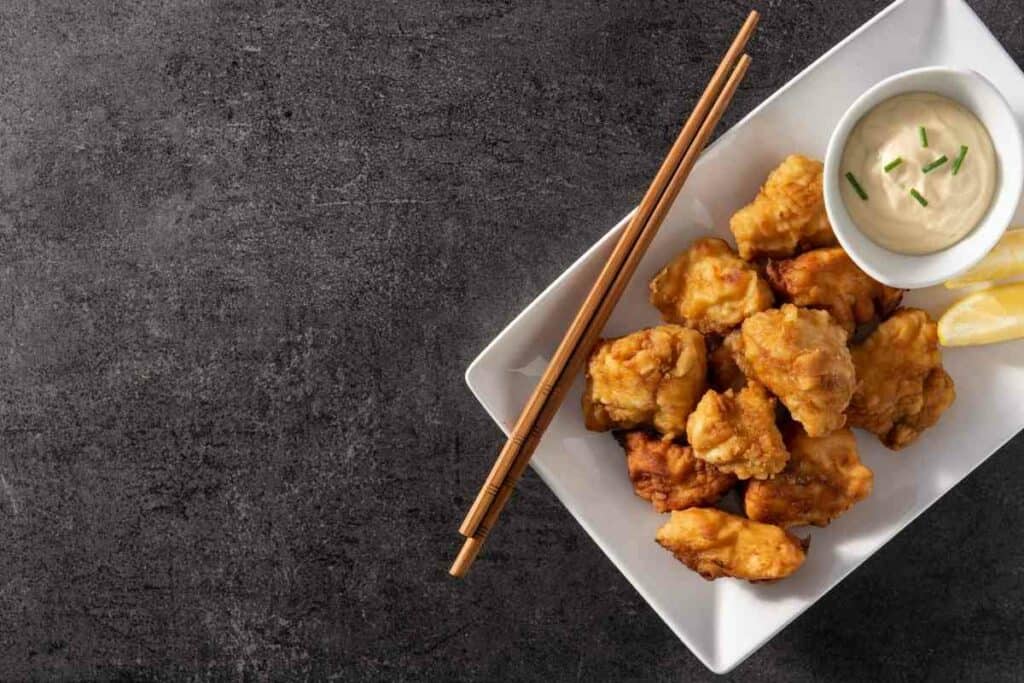
It also has many other seasonings. The standard recipe applies a potato starch coating on the chicken, but this varies depending on the flour used.
The ingredients give karaage a distinct and delectable taste, especially when paired with some mayonnaise and a slice of lemon.
It’s more fun to try out different vendors, as each uses a unique marinade and frying technique.
For example, Japanese fried chicken perfectly complements a glass of cold beer.
3. Okonomiyaki
Okonomiyaki is a savory Japanese pancake made using whatever you can find.
Common batter ingredients include cheeses, eggs, meat, vegetables, and seafood, mixed with flour.
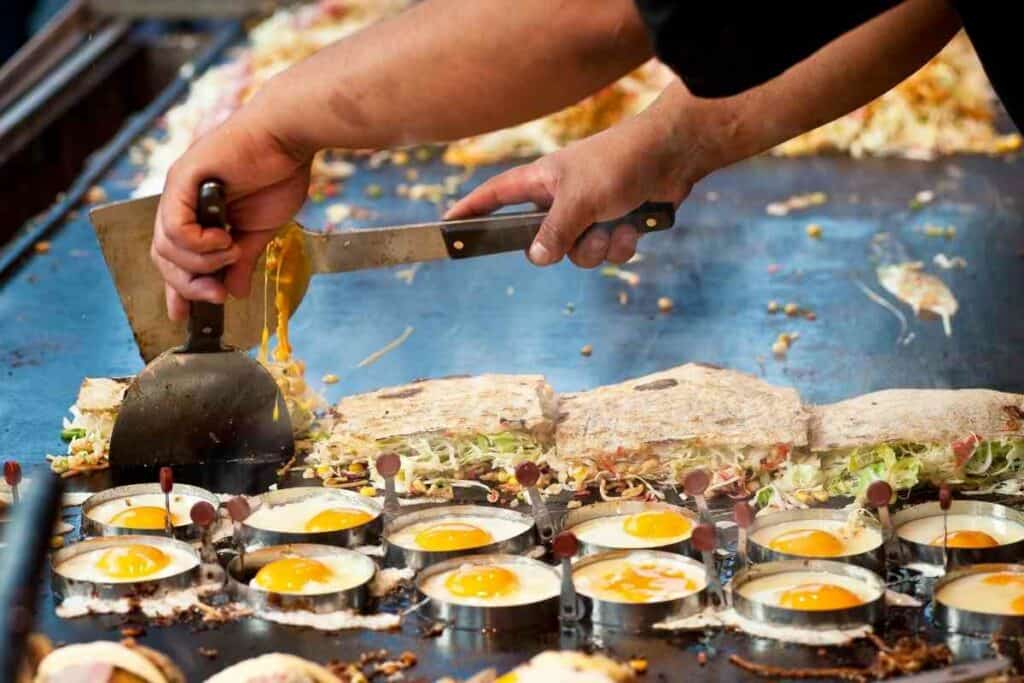
Like standard pancakes, cooking involves pouring the batter onto a pan and flipping both sides until it’s ready.
Toppings include bonito flakes, mayonnaise, pickled ginger, seaweed, and special sauce.
In addition, some food vendors allow customers to make okonomiyaki, mixing the ingredients in a bowl and cooking on a small grill.
The sweetness, saltiness, and heartiness make okonomiyaki a popular dish among Japanese locals.
4. Yakisoba
Yakisoba is the Japanese variety of fried noodles. The meal is similar to Chinese chow mein and usually contains a variety of meats and vegetables.
Locals like using cabbage, carrots, onions, and pork.
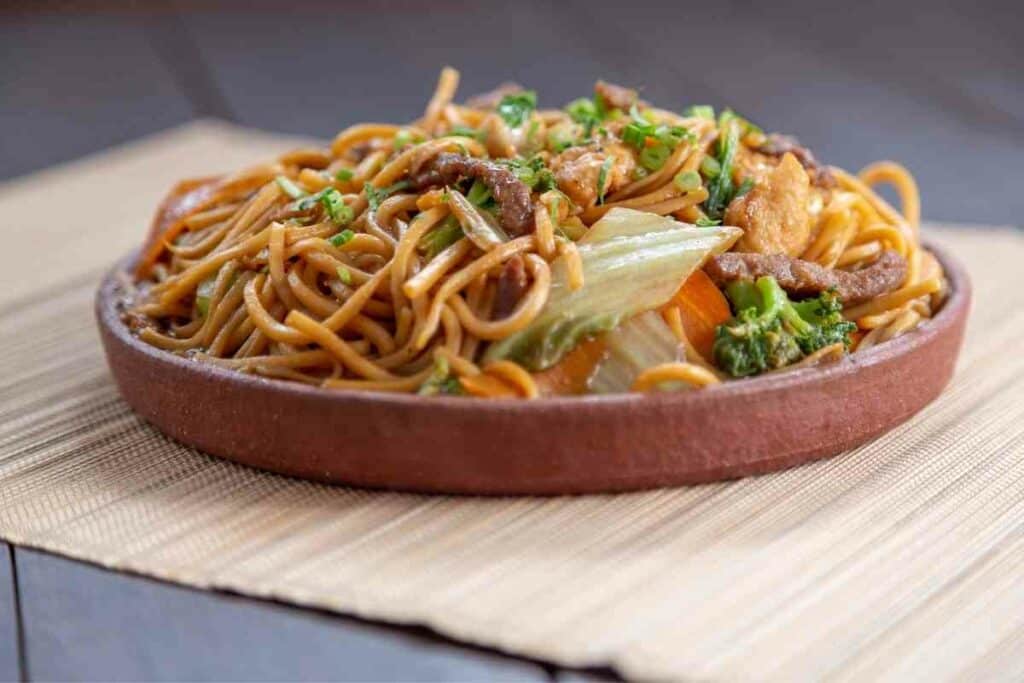
Noodle varieties used to make yakisobas are ramen noodles or soba noodles.
Although the name ‘yakisoba’ originates from soba noodles, ramen is still the most used middle type for preparing the dish.
After stir-frying the meats and veggies and cooking the noodles, chefs add a gooey yakisoba sauce that resembles Worcestershire sauce.
Yakisoba noodles are popular in restaurants, roadside stalls, and homes throughout Japan.
Since there’s no standard recipe, every yakisoba dish has a unique taste.
Usually, yakisoba is served on a plate filled with toppings like dried seaweed, fish flakes, mayonnaise, and pickled ginger.
Sometimes, yakisoba takes sandwich form, served in a special bun and garnished with special Japanese mayonnaise and pickled ginger.
5. Dango
Dango is a delicious street food consisting of skewered rice dumplings made from glutinous rice flour, uruchi, and water.
The balls are then boiled until firm to create a chewy mochi-like texture and then topped with a variety of tasty sauces and pastes.
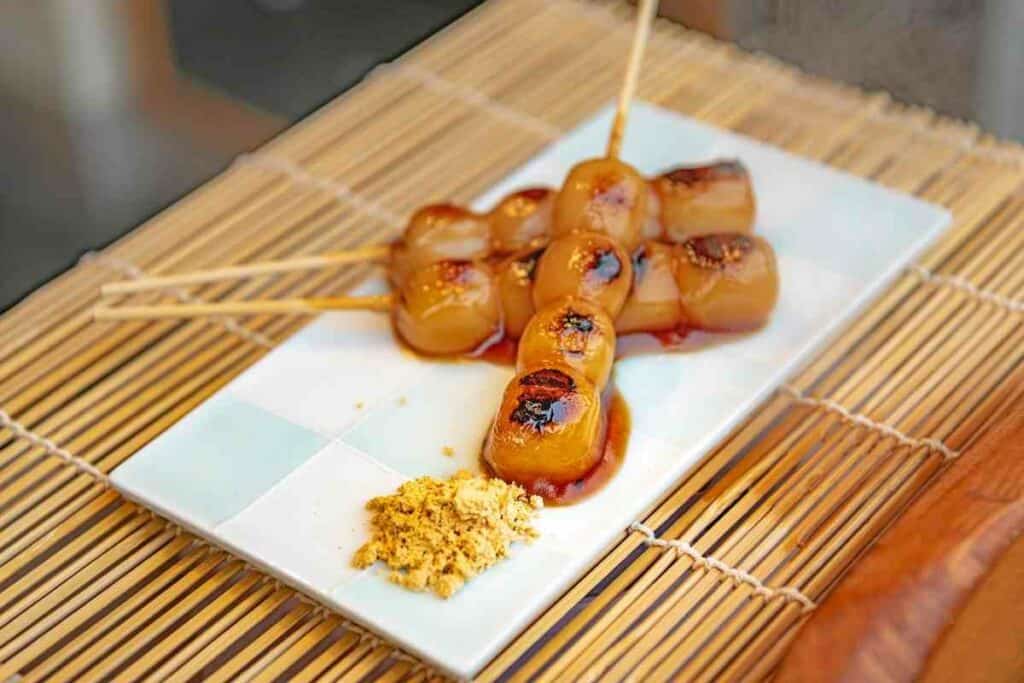
The most popular type of dango is mitarasho dango. It’s covered with a sweet, salty soy sauce mixed with starch and sugar.
People love it for its contrasting tastes and textures.
Other popular toppings are kinako (roasted soybean flour) and anko (red bean paste).
The topping determines the best dango accompaniment, but most flavors go well with green tea. Dango is also a great dessert and snack.
6. Yaki Imo
Yaki imo is a traditional Japanese street delicacy made from roasted sweet potatoes, famous for its sweet, candy-like taste.
It’s worth noting that not all sweet potatoes make this dish; rather, it’s a specific type called satsuma-imo.
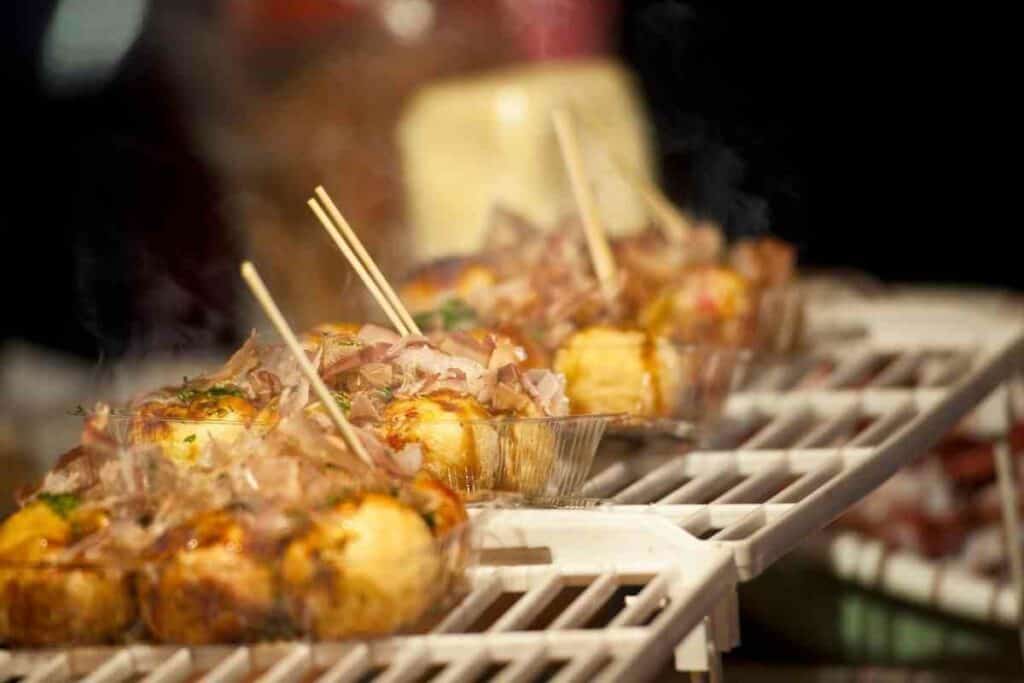
The potatoes are baked or roasted over a charcoal grill and served in paper packets.
Besides the sweetness, the sweet potatoes have a pleasant aroma that draws you to the vendor whenever you walk along a street.
Daigaku imo, which means ‘university potato,’ is a popular variation of yaki imo.
In the 20th century, sweet potatoes were cheap, prompting the attention of many university students.
As a result, the dish got its name. Today, daigaku imo is still popular.
However, it’s prepared differently – small potato pieces are deep-fried, coated with a sweet syrup, and topped with sesame seeds.
7. Miso Soup
Miso soup mostly consists of dashi and miso paste. Other ingredients include dried seaweed and tofu.
Although it’s available throughout the day, most locals consume miso soup for breakfast.
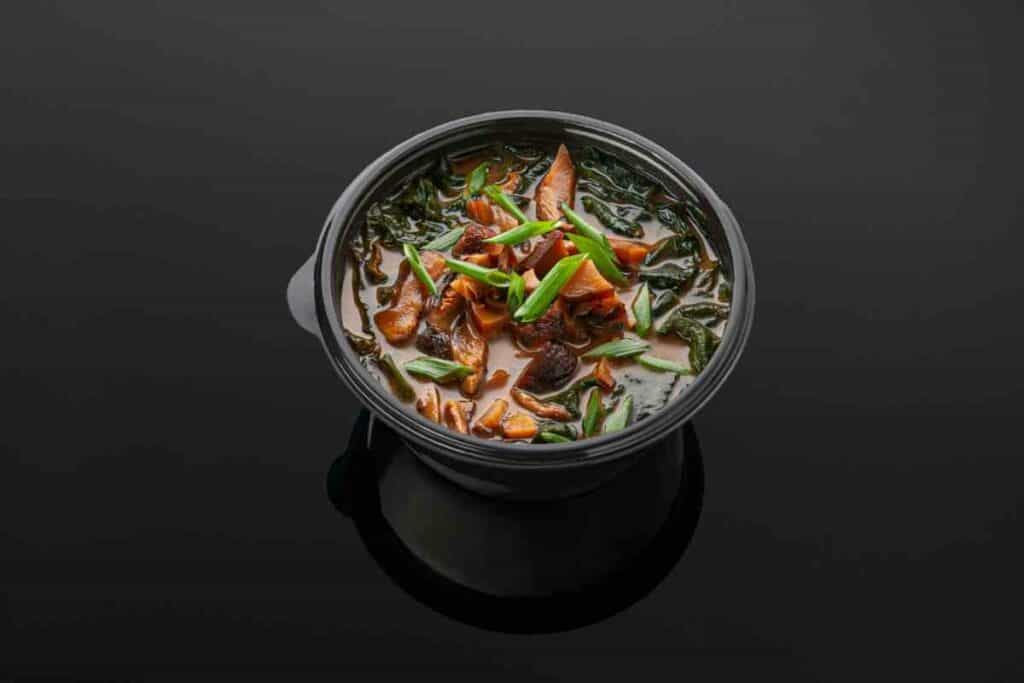
Its main ingredient, miso paste, is a mixture of rice, salt, water, and fermented soybeans. The paste has a similar texture to peanut butter.
Miso has existed for many years and originates from Chiang, China, where Buddhist monks invented it.
Since it’s easy to prepare, you can find several vending machines along the streets. This is a testament to the soup’s popularity.
In western countries like the United States, miso soup serves as an appetizer.
Some claim that the soup has medicinal value because it is alkaline and rejuvenates the nervous system.
8. Gyūdon
Gyūdon is an affordable and popular Japanese fast food. The dish consists of beef and onions served with a bowl of rice.
Meat and onions are cooked in a mixture containing mirin, sake, soy sauce, and sugar, resulting in a salty-sweet flavor.
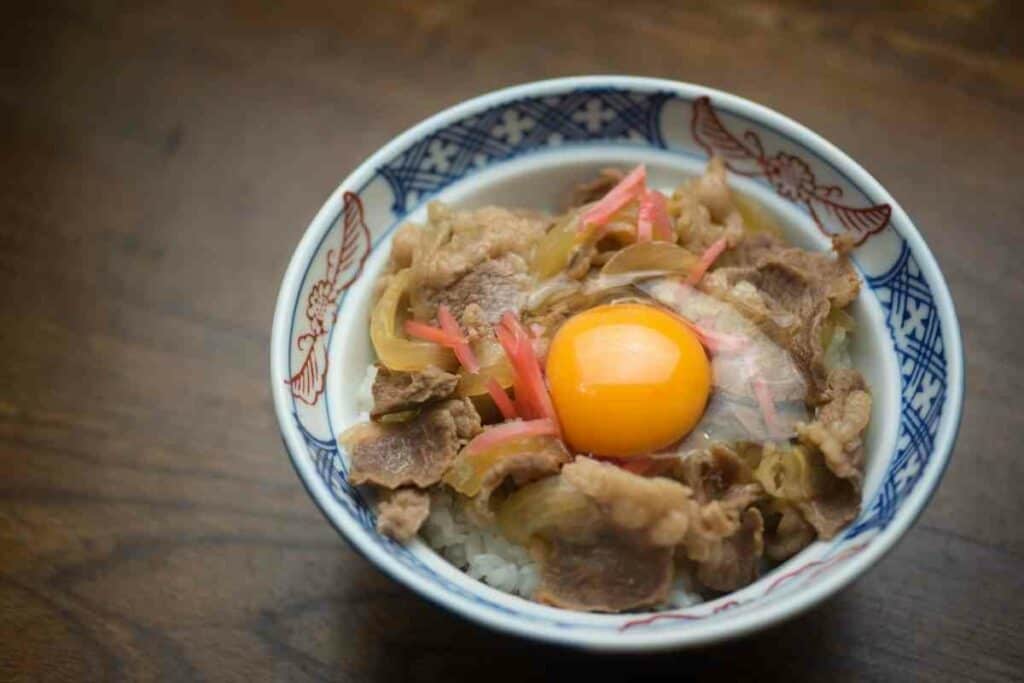
The dish originated from Kanto and is still liked for its inexpensiveness and nutritional value.
In restaurants, it’s called gyūdon-ya and is served alongside red chili and ginger, which you can use for seasoning.
Gyūdon-ya is a favorite for students and others who want a cheap, satiating meal.
Common gyūdon garnishes include green and red onions.
Sometimes, a beaten raw egg is added to the dish. Popular accompaniments to gyūdon are kimchi, miso soup, and vegetable salads.
9. Crêpes
Crêpes are a famous French dessert, but you can find them on many roadside food stalls in Japan.
Food trucks in the Harajuku streets in Tokyo introduced this treat to Japan.
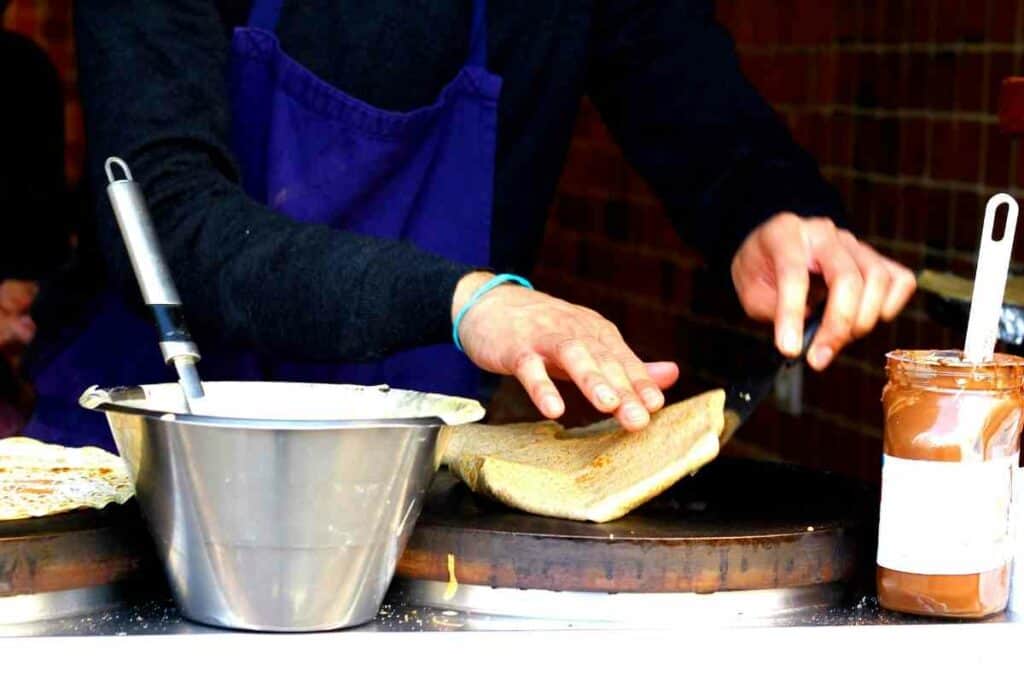
Harajuku is Japan’s most famous fashion hub. Crêpes were the cutest complement to the high-end clothing sold on the street.
A standard crêpe consists of blended fruits, sauces, and whipped cream. Crêpes are classified according to their flavor and appearance.
Popular flavors in Japan include matcha, mocha, and red bean paste. In spring, cherry blossom crêpes draw attention, while in autumn, the most popular flavors are pumpkin and sweet potato.
10. Imagawayaki
Imagawayaki are bean-filled pastries that look like Taiwanese red bean cakes or wheel cakes. The pastries are prepared on round flat disks made of cast iron.
Traditional imagawayaki were cooked until crispy and filled with sweet azuki bean paste.
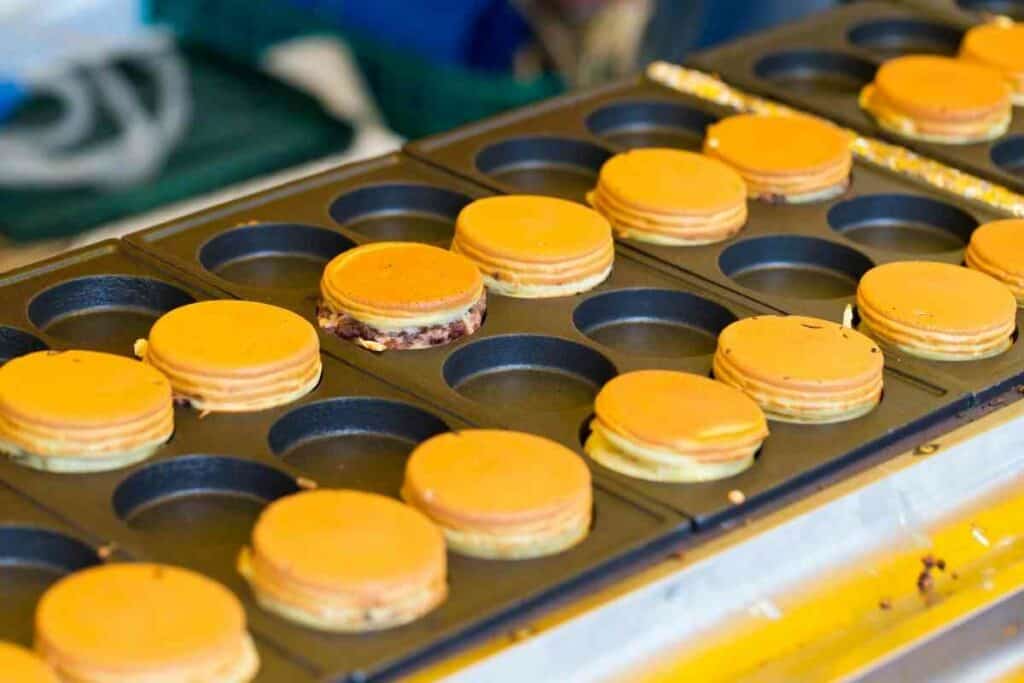
Nowadays, chefs use chocolate, fruit custard, matcha, and vanilla custard as fillings. In addition, you can request curry, cheese, or potato fillings if you like.
Imagawayaki are available all year round in Japan, during festivals, and inside restaurants.
However, it’s worth noting that the disk has a different name in the Kansai region, comprising Kyoto, Nara, and Osaka. There, it’s known as kaitenyaki or obanyaki.
11. Bento
Bento stands to experience high customer influxes at lunchtime, and understandably so.
The meal is an assortment of meat, rice, and vegetables packed in a neat, compact box. It’s why bento sells out fast, and you often have to book to avoid missing out.
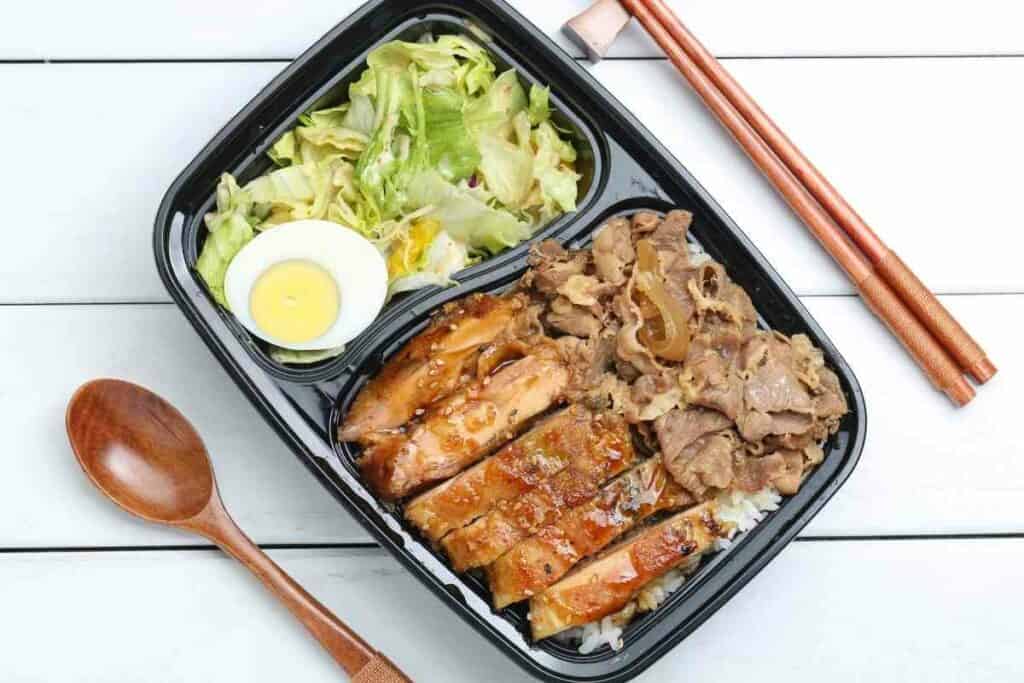
Popular bento types include beef steak bento, chicken teriyaki bento, and grilled salmon bento. Others, like egg and tempura shrimp bentos, are less popular.
If you aren’t an expert on traditional Japanese cuisine, bento presents an easy option.
You don’t have to know it by name – all you need to do is to point at your preferred box.
Street Food Etiquette in Japan
As mentioned, etiquette is why Japan isn’t famous for street foods.
You won’t see people gobbling noodles alongside Japanese streets, a common behavior in Thailand, the Philippines, and Vietnam.
Instead, locals consider it uncouth to eat while walking, and markets have signs telling you to eat the food where you bought it.
Most tourists are unconscious of this tradition. However, even if you can’t read Japanese, the demeanor of other customers should guide you in making the right decision.
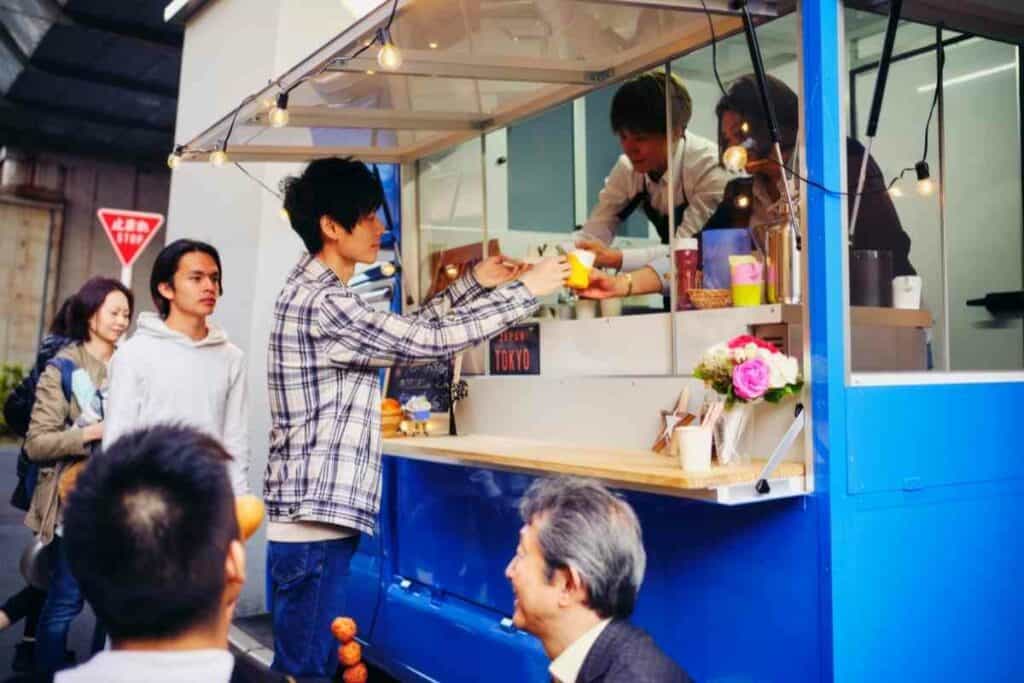
Go to a park if you can’t eat at the food stall or convenience store. Remember to dispose of the wrappers responsibly.
Still, you won’t look extremely out of place if you walk around while eating.
Locals are used to seeing foreigners do it, and the behavior is gaining social acceptance.
Some areas, such as Ameyoko Market and the Nakamise Street in Tokyo, accept tabe-aruki, which translates to eating while strolling.
However, asking if you can eat while walking is best, especially if the signs are in Japanese. Some places are yet to warm up to the idea.
Where Can You Find Japanese Street Foods?
Here are the best five spots to get street food in Japan.
Nakasu Street, Fukuoka
Nakasu is arguably the most iconic street food hub in Japan. It’s located in Fukuoka, a port city on Kyushu island.
Locals and tourists flood the infamous street from 6 p.m. onward to enjoy tasty dishes.
You can try yakitori, oden, and tempura shrimps. In addition, you can eat savory mentaiko and other salty seafood if you love strong flavors. Ramen noodles are also plentiful.
Hoppy Street, Tokyo
Hoppy Street is only two blocks from Nakamise Dori, Tokyo’s tourist hotel hub. It’s famous for its many small restaurants with a café layout, where seats line up along the roadside.
The street gets its name from the light beer served in ikizaya, traditional Japanese pubs.
Famous delicacies in Hoppy Street include beef stripes, stew, and sashimi. If you’re on a budget, you can try yakisoba, yakitori, and karaage.
Kuromon Market, Osaka
Osaka is a must-visit for foodies, especially if you’re into street food. However, with countless options, it’s hard to choose where to start!
Even better, most vendors allow you to sample the food before buying.
You can starve yourself before visiting Kuromon, as you’ll have more than enough to eat.
Popular dishes include takoyaki, wagyu beef, and a broad range of seafood, including crabs, shrimp, tuna, etc.
Nishiki Market, Kyoto
The Nishiki Market gives you a glimpse of the diversity of Japanese cuisine.
With over 100 food stalls, this 400-year market has many dishes to cater to everyone’s needs. Even the pickiest can find a good they love.
You can enjoy Japanese-style omelets, croquettes, tuba, and crunchy sesame seeds while exploring Gion, a district famous for its geishas.
Okage Yokocho, Mie
The Mie Prefecture is unpopular among tourists, but it is a worthwhile visit if you treasure Japanese history.
In addition, you can learn more about Ama divers, Ninjas, and Shintoism there.
Okage Yokocho is a street near the Ise Grand Shrine, the principal place of worship for Shintoism. Typical local snacks include dango and imagawayaki.
You can also enjoy tasty meals like curry rice, sushi, and a variety of seafood. It’s a great stop before and after visiting the shrine.
Wrapping Up
Regardless of where you visit in Japan, there’s always a spot that sells mouth-watering street foods.
So you’re guaranteed to get a dish that satisfies your taste buds. Better yet, you can sample the food before purchasing.
Read Next
- Bubble Tea vs Boba Compared: What’s the Difference?
- Best Izakaya Foods for a Relaxed Night Out (My Top 10 Picks)
- Edo Kiriko Whiskey Glasses (Japanese Heritage in Every Pour)
- Japanese Viral Foods on Social Media (Discover the Top 10)
- Amezaiku: 10 Amazing Examples of Japanese Candy Art
- 25 Must-Try Japanese Desserts: Old and New

